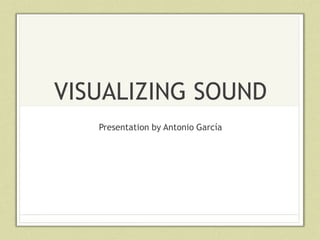Visualizing sound by Antonio G
- 1. VISUALIZING SOUND Presentation by Antonio Garc├Ła
- 2. Introduction Hello! My name is Antonio Garc├Ła, and IŌĆÖm from Mexico. This brief presentation is part of what IŌĆÖve learned during the first week of the ŌĆ£Introduction to Music ProductionŌĆØ course on coursera.org, by Berklee college of music. Today weŌĆÖll be reviewing some information about how some visual graphics help us to understand sound and its relationship with other elements in a better way.
- 3. Overview I will show the highlights about three of the most common graphics/displays- The Oscilloscope, the Spectrum Analyzer, and the Sonogram/Spectrogram analysis. Studying and understanding the importance of these visual displays is essential for a music producer, because trying to connect different frequencies and sounds with numbers or letters is a very hard task for anyone who has never seen it on screen. Furthermore, a couple of displays will allow us to check into every little overtone or harmonic that would otherwise be impossible to detect with our ears alone. I will be using the letter x and y to refer to vertical and horizontal axis, respectively.
- 4. The Oscilloscope Main window of a DAW, showing the typical Oscilloscope style visible tracks.
- 5. The Oscilloscope ItŌĆÖs one of the most used displays for audio. Even if you are not into production, you may already recognize this graphic easily when you see it first in any DAW. The disadvantage from this graphic is that itŌĆÖs not practical to recognize different frequencies; and in order to do so, you would have to count the ŌĆ£cyclesŌĆØ or ŌĆ£hertzŌĆØ during a certain amount of time. However, itŌĆÖs really useful to use the Oscilloscope graphic type when recording different instrument tracks, because of how easy it is to visually adjust the decibel levels and do a quick ŌĆ£mixŌĆØ of the whole project on the go. The basic layout for this display is to show X = Time and Y = Amplitude.
- 6. Spectrum Analyzer The spectrum analyzer shows sound waves as ŌĆ£bumpsŌĆØ in the display. The layout of this graphic shows: X =Frequencies, Y = Amplitude.
- 7. Spectrum Analyzer ItŌĆÖs important to mention that, while this display clearly shows the frequencies in sound, it doesnŌĆÖt show the progression of that sound as time passes, unlike the Oscilloscope display. On the other hand, you can clearly see all the overtones and harmonic frequencies on the picture in the last slide, as well as their amplitude. This graphic is very useful when applying compressors, limiters or when using equalizers to shape our sound. This is very important, because all those different overtones are what change the timbre* of an instrument. *timbre:the quality of tone distinctive of a particular singing voice or musical instrument, given by its overtones
- 8. Sonogram/Spectrogram Analysis Basic Sonogram example. X= Time, Y= Frequencies, Z= Amplitude (color)
- 9. Sonogram/Spectrogram Analysis While the amplitude is not that clear on this display, it shows all of the previous three factors involved. The amplitude is shown by the intensity of the colors of each bar, depending on the software used. Some DAWs use a blue/green hue, while some others use red colors. Spectrograms are sometimes used as a tool for creating different timbres and software instruments by changing the intensity of different frequencies over time or creating new ones. All of the three different visual tools should be used in conjunction to get the most out of it because of all the different advantages and disadvantages involved.
- 10. Reflection IŌĆÖm really happy to be part of this whole course. IŌĆÖm trying very hard to grasp all this new information to complete the assignments. IŌĆÖm open to criticism and any comment you need to point out about my presentation, feel free to tell me; I would be pleased to correct any mistakes in future work, and IŌĆÖll keep practicing my English to add emphasis and articulation/vocabulary on texts. Thanks a lot for reading and taking your time! ’üŖ ’üŖ










